Are you a Quiet Speculation member?
If not, now is a perfect time to join up! Our powerful tools, breaking-news analysis, and exclusive Discord channel will make sure you stay up to date and ahead of the curve.
September 2015 will always be remembered as the month where Lantern Control won a Modern Grand Prix. If that's not the sign of a diverse metagame, then I don't know what it is. The last month saw a lot of movement around our tier 1 and tier 2 decks, all of which you can check out on the recently updated sidebar or on the Top Decks page. We have a good mix of longtime staples taking a clear format lead (Affinity), some decks returning to the spotlight (Abzan and Infect), and even some newcomers making their long-deserved mark on Modern (UW Control). Let's just say I'm "galvanized" by the tournament finishes and it's a great time to play Modern.
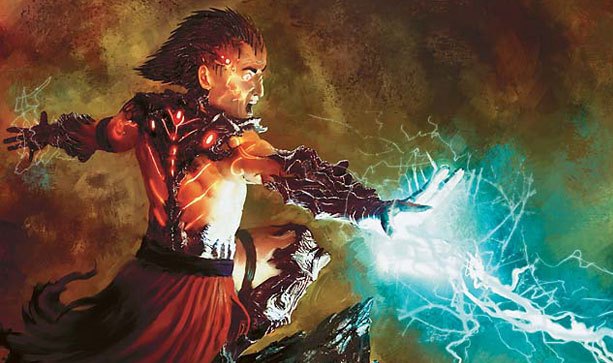
In this months' metagame update, we'll break down the tier 1 and tier 2 decks to isolate trends you need to be aware of. We're entering an off-season in October and November, and Modern off-seasons tend to be heavily influenced by the preceding months of metagame data. If you have any interest in getting ready for the big events at the end of the year, or grinding some local scenes in the autumn, this article will equip you with the metagame knowledge you need to know. We'll also revisit my metagame predictions from the 8/1-8/31 article to see if our format forecasts were hits or misses.
[wp_ad_camp_1]
Tier 1 Decks
As much as I love Lantern Control and respect Zac Elsik for his finish, it's a bit unfair to use Lantern Control as the characterizing Modern event of September. Lantern Control is nowhere near tier 2, let alone tier 1, and there were many other top-tier decks that defined and shaped the format. In a surprising turn of events for a big tournament month, September saw the tier 1 field open up instead of narrow. We're back to seven decks in that top-tier, which is the same count as we saw in the July breakdown but a very different composition.
As always, tiering is prevalence-based and not performance-based, although our emphasis on tournament T8/T16 finishes can serve as a stand-in metric for something like match-win-percentage. Prevalence-based tiering doesn't necessarily show which decks are best, although the stats can be strongly suggestive. Instead, it shows which decks are common: you can bet you'll face the tier 1 decks in a major tournament. Of course, these decks wouldn't see such wide play if they were bad decks, so there's an element of performance tracking here as well.
Now that's a wild and wacky tier 1. On one end of the spectrum, we see Affinity with a whopping 11% metagame share, which is the highest share for any single deck since we started recording metagame information in April. On the other end, we see Infect and Abzan surge back into tier 1, Merfolk stick around for another month, and RG Tron climb back into the fray. We also see a second consecutive month without a single Twin variant in tier 1. Before we dive into these changes, let's look at these decks' trends between now and June.
Holy Affinity, Batman. Although there are a number of interesting trends in this table, the best entry point to the September metagame is definitely Affinity's meteoric rise from a downward-trending share to the format's most-played deck.
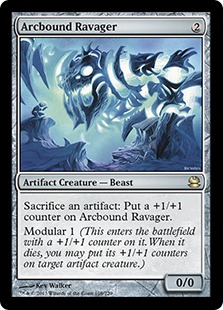 If you're unhappy with Affinity's September rise, you have no one to blame but yourself and Kolaghan's Command. As we've hopefully learned this time, when you cut all your Stony Silences, Ancient Grudges, and other anti-Affinity hallmarks, you're gonna have a bad time. This means not leaning too heavily on Kolaghan's Command when you need better interaction to stop the robot horde, even if Command is the hot new card everyone wants to play. Jund and Grixis players are guilty of this, as are their opponents who are metagaming too heavily against Jund and Grixis players. Affinity prospers when forgotten about, and with the deck languishing around a 6.9% metagame share in August, it was a great time for Affinity players to make a September resurgence. We didn't even have any Twin to stop Ravager and friends, which is itself an interesting phenomena we'll discuss later.
If you're unhappy with Affinity's September rise, you have no one to blame but yourself and Kolaghan's Command. As we've hopefully learned this time, when you cut all your Stony Silences, Ancient Grudges, and other anti-Affinity hallmarks, you're gonna have a bad time. This means not leaning too heavily on Kolaghan's Command when you need better interaction to stop the robot horde, even if Command is the hot new card everyone wants to play. Jund and Grixis players are guilty of this, as are their opponents who are metagaming too heavily against Jund and Grixis players. Affinity prospers when forgotten about, and with the deck languishing around a 6.9% metagame share in August, it was a great time for Affinity players to make a September resurgence. We didn't even have any Twin to stop Ravager and friends, which is itself an interesting phenomena we'll discuss later.
It's tempting to point to Affinity as the defining condition for September's metagame. I would look instead a few months back to Grixis' and Jund's respective rises. As we saw throughout August and September, players were so intent on beating Grixis and Jund decks in fair, midrange slugfests that they forgot about Modern's oldest tier 1 deck. This hyper-preparedness ended up invalidating the very condition it was supposed to address, as Grixis and Jund retreated and were replaced by new tier 1 entrants.
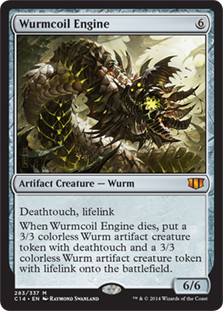 One of those "new" entrants was RG Tron. The last time we saw Tron in tier 1 was June, back when the format was Jund-crazy and Tron was the perfect antidote. With tournament-goers too worried about Tasigur and Goyf ground wars and Snapcaster/Command value, Tron was waiting to go over the top of anyone too interested in grinding. Stony Silence is also nowhere to be seen in this metagame, which is exactly what Tron players are looking for. As with Affinity, Tron is a deck that really benefits from Twin's relative absence from Modern's upper echelons. It also benefits from metagames where not one but two BGx decks are tier 1. All of these conditions virtually guaranteed Tron's return to the top.
One of those "new" entrants was RG Tron. The last time we saw Tron in tier 1 was June, back when the format was Jund-crazy and Tron was the perfect antidote. With tournament-goers too worried about Tasigur and Goyf ground wars and Snapcaster/Command value, Tron was waiting to go over the top of anyone too interested in grinding. Stony Silence is also nowhere to be seen in this metagame, which is exactly what Tron players are looking for. As with Affinity, Tron is a deck that really benefits from Twin's relative absence from Modern's upper echelons. It also benefits from metagames where not one but two BGx decks are tier 1. All of these conditions virtually guaranteed Tron's return to the top.
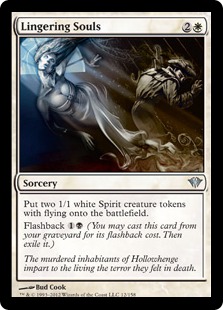 Abzan also benefited from this context, emerging from the pile of grinding decks as the grindiest of them all. If you're going to try and beat Grixis and Jund decks on value, it doesn't get any better than Lingering Souls. A single copy of Souls clogs up the board against Angler and Tasigur for four turns. It's also perfect pitch-bait for enemy Kolaghan's Command, and lets you get more mileage out of the midrange mistress herself, Liliana of the Veil. Abzan also has access to Path to Exile, which, unlike the venerable Bolt, lets you blow up enemy delve creatures for just a single card. I don't think we'll see Abzan surpass Jund anytime soon (Bolt is still too good as the format quickly shifts back to decks like Infect, Affinity, and Burn), but I do expect Abzan to stick around in tier 1 for at least a few more months. As an added bonus, Abzan can actually bring Stony Silence to bear in the Affinity matchup: I'm not convinced that's better than having game 1 Bolts, but it is a strong incentive for many players.
Abzan also benefited from this context, emerging from the pile of grinding decks as the grindiest of them all. If you're going to try and beat Grixis and Jund decks on value, it doesn't get any better than Lingering Souls. A single copy of Souls clogs up the board against Angler and Tasigur for four turns. It's also perfect pitch-bait for enemy Kolaghan's Command, and lets you get more mileage out of the midrange mistress herself, Liliana of the Veil. Abzan also has access to Path to Exile, which, unlike the venerable Bolt, lets you blow up enemy delve creatures for just a single card. I don't think we'll see Abzan surpass Jund anytime soon (Bolt is still too good as the format quickly shifts back to decks like Infect, Affinity, and Burn), but I do expect Abzan to stick around in tier 1 for at least a few more months. As an added bonus, Abzan can actually bring Stony Silence to bear in the Affinity matchup: I'm not convinced that's better than having game 1 Bolts, but it is a strong incentive for many players.
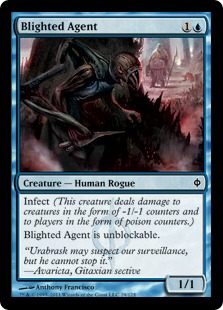 The other big tier 1 winner is, of course, Infect. Since June, Infect has slowly crept up from the low 3% shares to its present prevalence of around 4.5%. The stars really aligned for Blighted Agent and his elite team, with almost every other metagame change directly benefiting Infect players. RG Tron up? Thanks for the great matchup. Abzan on the rise? Thanks for yet another great matchup. Twin falling into tier 2? Thanks for eliminating one of the deck's worst matchups. Infect rose to notoriety back in early 2015 following Become Immense's introduction to Modern and the Abzan glut of February: we are seeing similar metagame conditions now and, so long as they persist, Infect is likely to remain a tier 1 player.
The other big tier 1 winner is, of course, Infect. Since June, Infect has slowly crept up from the low 3% shares to its present prevalence of around 4.5%. The stars really aligned for Blighted Agent and his elite team, with almost every other metagame change directly benefiting Infect players. RG Tron up? Thanks for the great matchup. Abzan on the rise? Thanks for yet another great matchup. Twin falling into tier 2? Thanks for eliminating one of the deck's worst matchups. Infect rose to notoriety back in early 2015 following Become Immense's introduction to Modern and the Abzan glut of February: we are seeing similar metagame conditions now and, so long as they persist, Infect is likely to remain a tier 1 player.
The rest of tier 1 is perhaps less interesting but no less relevant. Burn and Jund remain big players, although both saw declining shares since August. Merfolk also saw a drop and although it doesn't enjoy the same lifetime membership status as Burn and Jund, it still has the shares needed to justify a stay in tier 1 for September. Of course, the other big stories in tier 1 aren't about what's there. They're about what isn't there, with both Twin and now Grixis Control slipping down to tier 2. We'll talk more about those soon but, overall, Modern's tier 1 has shaped up to be an unusually diverse, albeit reactive, collection for September.
10/7/2015 - Author's edit: I made this disclaimer in my last article on the metagame and want to explicitly re-state it here. "With all three Twin archetypes down in tier 2, you should be preparing for any Twin deck, not just a specific representative." No single Twin deck is tier 1. All the Twin decks collectively, however, make up enough of the metagame that you should prepare for them before events.
Tier 2 Decks
As in previous months, September's tier 2 standings are where Modern's real diversity lies. In fact, our current tier 2 is even more diverse than usual because we have not one but two historically tier 1 decks falling down into the tier 2 crush. Unlike tier 1 decks, which you can count on appearing in most large events, tier 2 decks are just decks you can reasonably expect to T8 with. Will you always face them? Not necessarily: some tier 2 decks will be big at one tournament and then totally absent at another. Can you bet on these decks doing well if you pilot them? So long as you have the skills needed to take them to the top, any of the tier 2 representatives should be great choices for an upcoming Modern event.
There are lots of small metagame shifts to talk about here, but, in the wise words of everyone's favorite Hobbit, I've put this off for far too long: why are Grixis Control and the Twin variants all down in tier 2? It's not even all the Twin decks either, with Temur Twin falling out of the rankings completely. It's up to us to figure out what happened here and why it matters for the overall metagame.
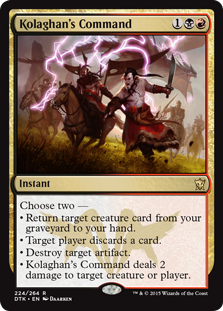 Let's start with Grixis Control because it's a much easier mystery. As we've seen in every event from Worlds 2015 onward, Modern players really don't want to lose to Grixis. They also don't want to lose to Jund but, as history has shown, there's only so much you can metagame against Jund, the 50-50 deck of Modern. Grixis has much clearer weaknesses and the format collectively turned against it from August through September. We're now in a metagame where Living End is a tier 2 deck, where Merfolk continues to enjoy tier 1 status, and where too many decks are trying to either go over Grixis players (Amulet and Tron) or just blast under them (Infect and Affinity). What's a Grixis mage to do? As the metagame stats have shown, the answer might be "not much", at least for now. Twin's decline is also at play here, because this was an interactive matchup that the role-shifting Grixis deck could thrive in. I'm sure Grixis Control will return to tier 1 soon, but with the metagame stacked as it is, it might be at least a month or two until that happens.
Let's start with Grixis Control because it's a much easier mystery. As we've seen in every event from Worlds 2015 onward, Modern players really don't want to lose to Grixis. They also don't want to lose to Jund but, as history has shown, there's only so much you can metagame against Jund, the 50-50 deck of Modern. Grixis has much clearer weaknesses and the format collectively turned against it from August through September. We're now in a metagame where Living End is a tier 2 deck, where Merfolk continues to enjoy tier 1 status, and where too many decks are trying to either go over Grixis players (Amulet and Tron) or just blast under them (Infect and Affinity). What's a Grixis mage to do? As the metagame stats have shown, the answer might be "not much", at least for now. Twin's decline is also at play here, because this was an interactive matchup that the role-shifting Grixis deck could thrive in. I'm sure Grixis Control will return to tier 1 soon, but with the metagame stacked as it is, it might be at least a month or two until that happens.
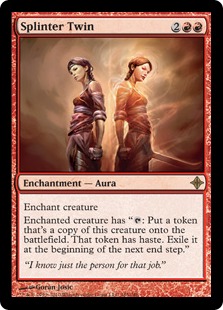 Then there's Twin. Unless I end up writing a banlist article for next week, there's a good chance I'll be doing a piece solely about Twin's metagame-wide decline. As someone who has been tracking metagame data since late 2012 and playing the format since 2011, Twin's absence from tier 1 is alarming in the same way we would all turn heads if the Patriots suddenly missed the NFL playoffs. Or, to use my hometown of Chicago as an example, if the Bears actually made the playoffs. For years, Twin decks seemed as eternal as Burn, Affinity, and BGx. I always refer to these four decks as the pillars of Modern, and although these recent metagame updates haven't changed that definition, it has me asking questions. After all, Twin's decline appears to be central to most of the other metagame changes in the format, and I'm just as curious as most readers about where this is coming from.
Then there's Twin. Unless I end up writing a banlist article for next week, there's a good chance I'll be doing a piece solely about Twin's metagame-wide decline. As someone who has been tracking metagame data since late 2012 and playing the format since 2011, Twin's absence from tier 1 is alarming in the same way we would all turn heads if the Patriots suddenly missed the NFL playoffs. Or, to use my hometown of Chicago as an example, if the Bears actually made the playoffs. For years, Twin decks seemed as eternal as Burn, Affinity, and BGx. I always refer to these four decks as the pillars of Modern, and although these recent metagame updates haven't changed that definition, it has me asking questions. After all, Twin's decline appears to be central to most of the other metagame changes in the format, and I'm just as curious as most readers about where this is coming from.
The first possibility I want to consider is statistical. Maybe Twin's decline is just a byproduct of our data analysis system and not a "real" decline. If so, Twin hasn't actually gone anywhere and at least one version is still tier 1, and our data tracking might just be missing it with inaccurate formulas. Although it's good we're thinking critically about these questions, I don't think this is at play in Twin's metagame drop. Just look at GP Oklahoma City's Day 2 breakdown to see this in action: Twin barely made a showing. We also know that Affinity is everywhere right now, which probably couldn't happen in a metagame with more Twin, further suggesting a real Twin decline. All of these factors, on top of the data itself, point to a legitimate Twin drop and not just a statistical anomaly.
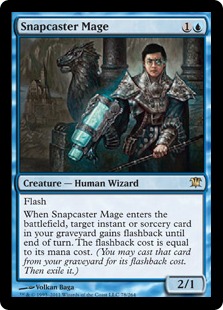 So if it's not a relic of bad data analysis, why is Twin falling? Affinity is probably Twin's best matchup, so it seems like Twin should be everywhere in this artifact-polarized metagame. Based on the data and my own understanding of the format, I believe Twin's decline comes at the intersection of player preference and player perceptions that extends all the way back to June. Four factors are at play here. The first factor is the rise of Jund, which many players perceive as an unfavorable Twin matchup even though it's in the 50-50 range. The second factor is the rise of Grixis Control, which pulled Snapcaster/Cryptic Command/Lightning Bolt players away from their Twin mainstay and into a spicy new control option. Third comes the rise of Grixis Twin, which pulled traditional UR Twin pilots away from their customary color pairing and into other options. As for the final factor, I'd point to a general "Twin fatigue" where weary Twin pilots switch away from a deck they have played for months or years into diverse options like UW Control, Grixis Control, Blue Jund, Temur Prowess, etc. We'd have to conduct a more rigorous data analysis to "prove" these explanations, but I think there is enough circumstantial evidence to suggest this is the case.
So if it's not a relic of bad data analysis, why is Twin falling? Affinity is probably Twin's best matchup, so it seems like Twin should be everywhere in this artifact-polarized metagame. Based on the data and my own understanding of the format, I believe Twin's decline comes at the intersection of player preference and player perceptions that extends all the way back to June. Four factors are at play here. The first factor is the rise of Jund, which many players perceive as an unfavorable Twin matchup even though it's in the 50-50 range. The second factor is the rise of Grixis Control, which pulled Snapcaster/Cryptic Command/Lightning Bolt players away from their Twin mainstay and into a spicy new control option. Third comes the rise of Grixis Twin, which pulled traditional UR Twin pilots away from their customary color pairing and into other options. As for the final factor, I'd point to a general "Twin fatigue" where weary Twin pilots switch away from a deck they have played for months or years into diverse options like UW Control, Grixis Control, Blue Jund, Temur Prowess, etc. We'd have to conduct a more rigorous data analysis to "prove" these explanations, but I think there is enough circumstantial evidence to suggest this is the case.
Looking to other tier 2 changes, the big two I want to highlight are the rise in decks benefiting from Twin's absence (Amulet Bloom and Living End are here), and the arrival of UW Control into tier 2. I'm not actually convinced UW Control is a good deck, but it definitely has a lot of hype around both its Sun Titan and its more traditional Snapcaster Mage versions. In fairness to Azorius fans, the deck has a number of high-profile wins behind this hype, so maybe the deck really is as good as some players are claiming.
Modern Metagame Predictions for 10/1 - 10/31
You can always count on these breakdowns to revisit past predictions, and this month I'm pleased to report a pair of homeruns from our August update. Merfolk and Kiki Chord let me down in August, but Infect and UW Control picked up the slack for September, performing exactly as expected in this diverse (and somewhat strange) metagame.
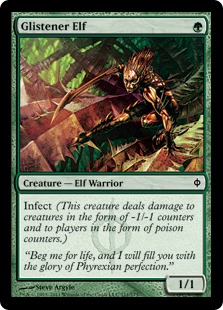 Infect will climb to tier 1? Yes!
Infect will climb to tier 1? Yes!
There were a lot of conditions at play in Infect's September rise, and I'm happy I successfully identified those pre-trends back at the beginning of the month. This is particularly interesting from a metagame history perspective, as it follows a similar trajectory to Infect's successes in January and February 2015. I expect we'll continue to see respectable Infect shares through October and November, when bigger shifts might signal Infect's decline. I also expect we'll see more Infect in future metagames if those months see similar format-wide trends: Infect's tier 1 ascension is a great learning point for us and one we should remember in later updates.
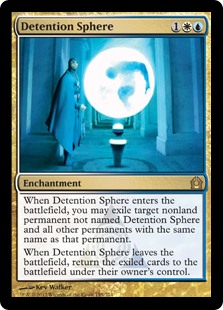 UW Control will move up to tier 2? Yes!
UW Control will move up to tier 2? Yes!
Two for two, baby! It could be argued that Infect's rise was not a very bold prediction (after all, the deck has been there before). UW Control, however, has barely cracked 1% of the metagame in past months. Today, it's at 2% of all the major metagame subsets, with a number of high-profile finishes backing it up. Sun Titan/Emeria, the Sky Ruin lists tend to generate the loudest buzz, but the standard combination of Ojutai, Finks, Angel, and others can be just as potent. You can see examples of these variations in Michael Segal's and Jessy Hefner's respective lists, one from SCG Charlotte and the other from SCG Cincinnati. It's too early to know if UW Control is here to stay, but early indications suggest it is.
We're entering another off-season month for Modern, where metagame shifts are generally more subtle and predictions can't be as bold. Battle for Zendikar is new on the Modern scene, but as last weekend's SCG Premier showed, preliminary indicators don't signal a strong BFZ impact. Based on the downturn in events and the general off-season limitations, here's a prediction I'm willing to make for October:
 UR Twin returns to tier 1
UR Twin returns to tier 1
I'm probably going to regret this when all those Tasigur fanboys and fangirls sling Grixis Twin instead, but I'm banking on UR Twin returning to the limelight in October. I just can't envision a metagame where Affinity is the most-played deck by over 3% point, and where Infect/RG Tron are both tier 1, that doesn't see a Twin comeback. Twin is even effective against Amulet Bloom, which is itself seeing more play in both MTGO and paper events: that maindeck Blood Moon does wonders. Twin players will still have to contend with the BGx players, notably the rise of Abzan and its Path trump to Exarch's four toughness, but that's familiar territory for experience Twin mages. I'm banking on UR Twin over Grixis Twin because Kolaghan's Command appears to have lost its luster, which should send players back to Twin. BBD's second-place performance at GP Oklahoma City should also encourage players to revisit UR Twin. All of this is likely to point to Twin's return to glory in October, although an upset is still possible.
We'll need to do some serious soul-searching as a format if Twin is still absent in October, but we'll burn that Ensnaring Bridge when we get to it.
That's all for our October metagame update. What trends do you see in the data that you think deserve attention? Any interpretations or narratives I missed? Any themes you would analyze differently? Let me know in the comments and thanks for tuning in to our metagame update. I look forward to seeing you all around the community forums and next week as I tackle either Twin's two-month downfall or some banlist testing.





Thanks for the informative article, as always. I’m with you in that UR Twin is probably going to make a comeback – I think people got too far away from the deck’s roots as an instant-win combo deck that scares the heck out of you all game long (that has control on the side) when it went Grixis, and the necessary corrections are en route.
I also think it’s high time that Grixis Delver seriously considered running Bob, as Jordan’s earlier article noted. I’ve been testing more or less his decklist (with some minor variations), and it’s been a dynamo. I feel like I’m in every game, and Bob is nice and safe when you curve out at 2. I’ve even managed to consistently battle Bogles, which is typically a miserable matchup for Delver. Do you predict that this idea will take hold?
For the most part, I think Modern players are relatively resistant to changing old decks unless big tournament events prove otherwise. Even then, it takes a lot of momentum and hype to get things changing. I just don’t think there’s enough interest in Grixis Delver as a deck for players to launch a movement to bring Bob into the deck’s 75. I think it’s a good idea in some metagames, but that doesn’t mean the good idea will catch on.
I vote for the banlist testing. Wait for some early results from October (say like three weeks in) and then look and see how/if your predictions are holding up, and if twin is STILL not making a comeback, dig in critically. I’d also point out that we have a GP coming up in philly, and that’s going to be the REAL test to see if twin is back in the metagame at large. It’s entirely possible that the SCG PIQ metagame has become somewhat inbred with the large number of grinders that play in a greater proportion of events. For example, I personally know of some silver-level players that don’t participate in the SCG circuit at all, but they’re extremely competitive modern players and are planning to attend the GP. If that story holds out for a large enough number of players (even 20 or 30 is enough “pro’s” to make a statistical impact at a GP), it’s possible you just have a subset of the “more competitive” (more likely to top 8 based on skill alone) playerbase that isn’t represented in data analytics that are firmly rooted in MTGO and SCG event showings.
Banlist testing seems more likely, and I agree that we need to wait on more Twin information. I also added a disclaimer to the article (you can read it down the first section) about how to further interpret the results. Twin is still a very decent deck and, as a whole, is one you should expect to face. But the individual Twin flavors don’t cut it in tier 1 on their own: it’s the Twin supertype you need to prepare for. That supertype is also still well-represented, at between 8%-10% of the format.
I see the fall of various Grixis flavours more as a problem with the blue color. When the format is so diverse, your counterspell suite becomes much more inneficient, because you can’t have the right numbers of snares, dispels, remands, thus giving decks that play proactively an edge. Maybe a counterspell unban would shake things up a bit, giving blue colors some more consistency against an diverse metagame we have, without invalidating other strategies.
Remember that Counterspell isn’t banned in Modern: it’s just not in a Modern legal set. So although Counterspell could help Modern players, there’s currently no way to get it into Modern without going through Standard (and that’s a topic for another time). I’m also not convinced it’s needed. We’re coming off a 3-4 month period of strong blue finishes. We shouldn’t assume something is wrong with blue based on just 2 months of data. We’ll need more time and information to see how the format shakes out.
See this is in general a great site, but series such as this give a real edge. We have facts, figures, interpretations, and predictions. Not aiming at any other site in particular but “Hey look at this ham sandwich that went 3-1. This is its max potential and you’ll never hear about it again, but ain’t it cool?” has quickly grown old. Keep up the good work
Glad you enjoyed it! We’ll keep trying to provide content like this, and let us know if there’s anything else you want to see.
Great article as always. Your predictions seem solid. I don’t think twin will stay out of the limelight for long, and I believe grixis control will resurface next season.
Those seem like solid predictions, although I will say that Twin as a supertype (URx Twin) is still very much in the spotlight. Collectively, the deck has an 8%-10% metagame share, so you would be wise to still expect some kind of Twin deck at a tournament. That said, there’s no individual Twin list you should prepare for: you just need to be ready for the general URx Twin synergies and gameplans. Hopefully we’ll see a Twin deck back in tier 1 soon!
“Instead, it shows which decks are common: you can bet you’ll face the tier 1 decks in a major tournament.”
Adding both Twin variants yields a 7.5% share of the metagame. This would tie Twin combo decks for the third most prevalent deck. With these numbers it would be foolish not to prepare for the matchup at a major tournament.
Grixis trades some countermagic for delve fatties a removal spells/hand disruption. I see them acting more like a delver deck (tempo behind an efficient beater) with an “Oops, I win” condition. I have a harder time coping with Twin as Jund on that game plan. Playing Tron is a little easier since hate cards like Blood Moon become a liability with three colors.
When analyzing Twin falling in popularity you should also include the printing of Rending Volley. Combust was always a popular hate card, but getting the same effect against twin for 1 mana evens out some matchups (post-board Tron, e.g.). Additionally, leaving open one mana is a lot less innocuous than the two needed for combust, sometimes yielding a 2:1 when they “go for it”.
I agree with everything you say here, and realize that this didn’t come through in the article above. I made a disclaimer to this effect in my August article, and I’ve just repasted it in this article her as some added clarity. Overall, it’s important for Modern players to know that no specific Twin deck is tier 1, but the collective URx Twin supertype is still seeing a lot of play. That said, it’s still fascinating to me that no single Twin deck is cutting it, with all the decks languishing at fairly low shares. Both of these observations are important and we should be mindful of them when preparing for events.
Is there any chance that if no one version of the Twin archtype makes teir 1 status that you could aggregate grixis and straight UR into one super-type?
The stratigies and countermeasures are largely the same for their main gameplan- and I feel like it does a disservice to your analysis to not group it in the tier 1 (expect to play against this) breakdown
Is there any chance that if no one version of the Twin archtype makes teir 1 status that you could aggregate grixis and straight UR into one super-type?
The strategies and countermeasures are largely the same for their main gameplan- and I feel like it does a disservice to your analysis to not group it in the tier 1 (expect to play against this) breakdown
UR/”x” Twin is 8% of the modern metagame. It might be declining, but it’s one of the four pillars. This is why I like less and less the criteria of separating UR Twin and Grixis Twin in the breakdown. There is very little upside in treating them apart, and a whole lot of confusion when just glancing at the data.
Having played against a lot of Twin in my time, I appreciate the important differences between these lists and how that can affect a game. For instance, UR Twin is the best Blood Moon deck in the format. If I’m an Amulet Bloom pilot and UR Twin is tier 1, I might want to expect some game 1 Blood Moons if I go to an event. If Grixis and Temur are in charge, there’s no way I’m seeing that tech in game 1 and will probably only see 1-2 in games 2/3. Perhaps this granularity is less important than collectively considering URx Twin as a whole, but I think we can do both. The key is just to acknowledge where collective deck shares push a supertype into tier 1, which is a disclaimer I made in my August update and have now pasted into this one (you can see the update in the middle of the article).
Of course, if this keeps happening and keeps leading to misinterpretations, we might have to change the classification system. Any system is going to have upsides and downsides, however, and we’ll continue weighing them as we process more data.
Am I wrong or is the only difference between UR and Temur twin tarmogoyf + ancient grudge? I am not aware of other green cards being played in twin decks.
And grixis twin plays what black cards? tasigur/angler (goyfs), and inquisition/kolagans command? Maybe replace roast with murderous cut?
Myself I find calling these 3 different decks really silly. It’s like considering affinity decks with master of etherium totally different decks from ones with ensoul artifact. Switching 2-4 cards in a deck that still executes a virtually identical gameplan…
Grixis Twin can be pretty different from the other Twins, especially in its sideboard. Just having Terminate as hard removal opens up options that you don’t see in the red-based removal in regular UR Twin (Bolt, Electrolyze, maybe Roast). Add to that a Kolaghan’s/Snapcaster value loop, a Tasigur plan B, a more painful manabase, inability to maindeck Blood Moon, and different sideboard options and you have yourself a surprisingly different deck.
UR Twin and Temur Twin have more similarities, especially when UR Twin splashes Breeding Pool for sideboard Grudge. Even there, however, the inability to maindeck Moon and the presence of Goyf plan B really change how the deck plays out. All of this matters both as Twin players deciding which deck to use, and then (more importantly) the impact of that choice on the metagame.
In the future, I’ll try and incorporate a way of tracking both the URx Twin supertype and the individual Twin variants that captures both without misleading readers. For example, maybe we report on URx Twin and then highlight which particular Twin variant is the current Twin-to-beat for the month.
I just don’t see how any of that is different from an affinity deck running day’s undoing, an affinity deck running master of etherium, an affinity deck running 4 thoughtcasts, or an affinity deck running frogmite. Of course every card you change has some impact on what the deck can do and what its good/bad against. But at its core what is the deck doing?
Do you know what all variants of twin are doing? Playing a humdrum midrange fair game backed up by a viciously unfair 2 card combo half of which has flash.
What defines a twin game? Your inability to tap out ever unless you want to risk losing on the spot irrespective of board state, hand state, or life total. Blood moon and less pain is the UR twin advantage – just like an abzan list with voice of resurgence has an advantage against counterspells and flash creatures…
Grixis twin runs very light on counters and heavier on disruption. It plays more proactive and less reactive. It’s more of a midrange deck.
Another great article, I really enjoy these monthly reviews! As a Grixis/UR Twin player, I can definitely say I was getting some sort of Twin fatigue and switched to Living End for a while. But I’m cool with Twin decks taking a back seat for a time, it night be when I do switch back, the meta will be ripe for the harvest!
Twin should be back soon. Until then, you’ll still want to prepare for them as a whole, even if there’s no one Twin deck that’s getting all the attention.
As a Patriots fan my favorite part in this whole article was your comment about the Bears. Still can’t believe you traded Brandon Marshall for a 7th round pick and kept Jay Cutler lol.
As far as magic is related, what are your thoughts on where allies have to potential to reach by the end of October? I have been playing bant allies (running 4 battlesingers because of CoS and Ally Encampment) and I have to say it might possibly be better than my delver deck. I think they have huge potential to blow up
On the bright side, especially after the Jared Allen trade for draft picks, there’s nowhere to go from here but up. At least until we lose Forte. But after THAT, we’ll have nowhere to go but up!
I personally love Allies, but I see two issues with the deck as far as metagame share goes. For one, Modern is a hype-driven format where many players are unwilling to strike out on their own with innovative lists. Grixis Delver was the most grassroots-driven deck evolution I’ve seen, and that was based on an existing shell (Delver) with clear new synergies (Grixis following Tasigur’s rise). Allies doesn’t have that kind of momentum, at least not yet. We would need to see Allies get T8 at a major event and, even then, it would still require a lot of buzz to take off.
The second issue with Allies is the lack of consensus around builds. We have Company Naya Allies, Jeskai Allies, 5-Color Allies, and probably a half dozen other Allies brews floating around we can all name or have seen. This means it’s hard to identify a best core, and harder for players to get excited about the deck. If I love Allies and test out a version that proves to be bad, I’m unlikely to keep trying out other versions. I’ll just go back to Naya Company or Merfolk. But if I love Allies and try out a T8/T16 list from a GP and it’s at least decent, I might stick around. Allies needs this consistency to be good and we’re not there yet.
Being an affinity pilot, I have seen the decline of twin in my local meta since GP Singapore. More people are playing Grixis and its variant archetype. I guess that is why affinity continue it’s success. However, since early this year till now, more affinity pilots are packing spellskite mainboard instead of sideboard which also partly due to kolaghan’s command. I don’t foresee spellskite to go back to sideboard statues unless decks start packing stony silence again. In recent tournaments, I also start seeing more brews than just tier 1 decks, therefore it could be that players are using down season to test out brews or trying new things from the new set. This trend could continue till the start of next modern season. Aside from tournament, magic is a game that ignites creativity, therefore archetype that do well might be taking a break to try new things or what you mentioned as twin fatigue. What I am most interested is how BFZ will stir up the current metagame with archetype like RG tron and scapeshift. The interest to test the brews might change the meta a fair bit if it caught on unless there are archetype that counter such strategy which might impede their popularity.
I have also seen the Twin to Grixis shift. I think it’s because a lot of Twin players are secretly control players, and they’d rather play Grixis Control than just URx Twin. Of course, it’s also possible they are just attracted to shiny new decks, but I think both forces are at play. As you also suggest, off-seasons are great times to try out brews, although I think we’ll start to see more Twin as players return to the deck following disappointing Grixis performances. This should lead to a downturn in Affinity by November, although BFZ block might result in a parallel rise in Tron, Scapeshift, and similar decks (they haven’t gotten big cards yet but that might change).
Killer content as always! This is quickly becoming one of my favorite sites for MTG articles.
Thanks for the props! If there’s any other content you want to see, or general feedback, definitely let us know!
I thought somewhy that Lantern Control will make it’s way to the tiers given all the hype it created, but it seems the deck is way more complex to play good and learn how exactly do it to make appearance in high meta in just one month. Will see though.
I don’t know if this is the right place to bring it up, but there’s a question I think is hanging in the air regarding these metagame analyses and no, it’s not related to how you group twin(!).
With the recent changes to prizes/entry fees and now the appearance of a Modern league, the number of people that participate in the Modern Daily on MTGO has dwindled. It’s essentially a daily 4-round tournament whose participation rate and structure compares to that of a decent FNM tournament. The one that’s currently running sports a mere 20 people compared to the usual 80+ that would attend before the changes.
With this development it seems bizarre that these events are given points on equal grounds to that of GP/PT Day 2s, GP/PT top8s or even the sum of all(!) published top8 paper events. I realize there’s sound reasons to keep dailies in their own category. It’s a different meta altogether with budget and linear decks running rampant while simultaneously being the only source of information for MTGO where a sizable portion of people play and deck development take place, but nevertheless equating what’s essentially the publishing of daily FNMs to categories that are either more populated or from more competitive environments skews the data which is problematic.
In your opinion, Is this something that can be addressed in a meaningful and practical way?
I think the best way to address this imbalance, which I also see from day to day, is to give less weight to MTGO numbers. We could probably figure out a good weighting based on relative attendances, but I’d have to crunch the numbers to figure it out.